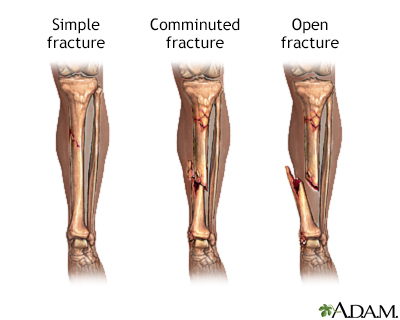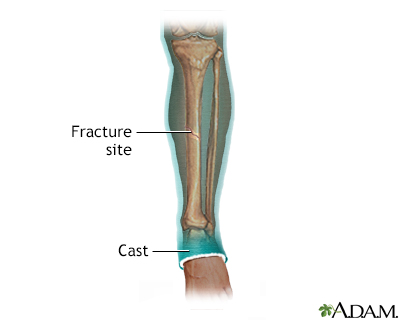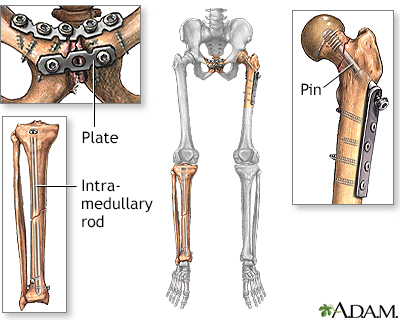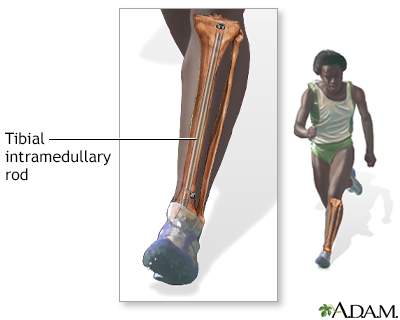Bone fracture repair - series

Indications
Fractures of the bones are classified in a number of ways. A simple fracture involves a single fracture line through a bone. A comminuted fracture is one in which the bone has been fractured into two or more fragments. An open fracture is one in which the fractured bone penetrates the skin.

Procedure
The three main treatment options for bone fractures are:
- Casting.
- Open reduction, and internal fixation- this involves a surgery to repair the fracture-frequently, metal rods, screws or plates are used to repair the bone, and remain in place, under the skin, after the surgery. This procedure is recommended for complicated fractures not able to be realigned (reduced) by casting, or in cases in which the long-term use of a cast is undesirable.
- Open reduction, and external fixation- this involves a surgery to repair the fracture, and placement of a external fixation device on the limb with the fracture. This device is an external frame which supports the bone and hold it in the correct position while it is healing. This technique is generally applied to complex fractures that cannot be repaired using open reduction, and internal fixation.

Procedure
While the patient is pain-free (general or local anesthesia), an incision is made over the fractured bone. The bone is placed in proper position and screws, pins, or plates are attached to or in the bone temporarily or permanently. Any disrupted blood vessels are tied off or burned (cauterized). If examination of the fracture shows that a quantity of bone has been lost as a result of the fracture, especially if there is a gap between the broken bone ends, the surgeon may decide that a bone graft is essential to avoid delayed healing.
If bone grafting is not necessary, the fracture can be repaired by the following methods:
a) one or more screws inserted across the break to hold it.
b) a steel plate held by screws drilled into the bone.
c) a long fluted metal pin with holes in it, is driven down the shaft of the bone from one end, with screws then passed through the bone and through a hole in the pin.
In some cases, after this stabilization, the microsurgical repair of blood vessels and nerves is necessary. The skin incision is then closed in the usual fashion.

Aftercare
The advantage of internal fixation is that it often allows early mobility and faster healing. Unless the internal fixation causes problems, it is not necessary or desirable to remove it. The long-term prognosis is excellent. The length of the hospital stay depends on factors such as the condition of the bone, the presence of infection, the state of the blood and nerve supply, and presence of other injuries. Children's bones heal rapidly, usually in 6 weeks time.
Related Information
Broken boneBACK TO TOP
Review Date: 6/17/2024
Reviewed By: C. Benjamin Ma, MD, Professor, Chief, Sports Medicine and Shoulder Service, UCSF Department of Orthopaedic Surgery, San Francisco, CA. Also reviewed by David C. Dugdale, MD, Medical Director, Brenda Conaway, Editorial Director, and the A.D.A.M. Editorial team.

Health Content Provider
06/01/2025
|
A.D.A.M., Inc. is accredited by URAC, for Health Content Provider (www.urac.org). URAC's accreditation program is an independent audit to verify that A.D.A.M. follows rigorous standards of quality and accountability. A.D.A.M. is among the first to achieve this important distinction for online health information and services. Learn more about A.D.A.M.'s editorial policy, editorial process and privacy policy. A.D.A.M. is also a founding member of Hi-Ethics. This site complied with the HONcode standard for trustworthy health information from 1995 to 2022, after which HON (Health On the Net, a not-for-profit organization that promoted transparent and reliable health information online) was discontinued. |
The information provided herein should not be used during any medical emergency or for the diagnosis or treatment of any medical condition. A licensed medical professional should be consulted for diagnosis and treatment of any and all medical conditions. Links to other sites are provided for information only -- they do not constitute endorsements of those other sites. © 1997- 2025 A.D.A.M., a business unit of Ebix, Inc. Any duplication or distribution of the information contained herein is strictly prohibited.
